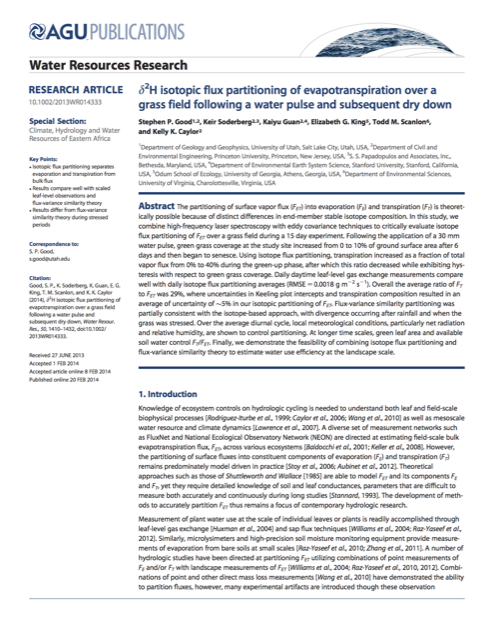δ2H isotopic flux partitioning of evapotranspiration over a grass field following a water pulse and subsequent dry down

Good, S. P., K. Soderberg, K. Guan, E. G. King, T. M. Scanlon, and K. K. Caylor (2014), δ2H isotopic flux partitioning of evapotranspiration over a grass field following a water pulse and subsequent dry down, Water Resour. Res., 50, 1410–1432, doi:10.1002/2013WR014333.
The partitioning of surface vapor flux (FET) into evaporation (FE) and transpiration (FT) is theoretically possible because of distinct differences in end-member stable isotope composition. In this study, we combine high-frequency laser spectroscopy with eddy covariance techniques to critically evaluate isotope flux partitioning of FET over a grass field during a 15 day experiment. Following the application of a 30 mm water pulse, green grass coverage at the study site increased from 0 to 10% of ground surface area after 6 days and then began to senesce. Using isotope flux partitioning, transpiration increased as a fraction of total vapor flux from 0% to 40% during the green-up phase, after which this ratio decreased while exhibiting hysteresis with respect to green grass coverage. Daily daytime leaf-level gas exchange measurements compare well with daily isotope flux partitioning averages (RMSE = 0.0018 g m−2 s−1). Overall the average ratio of FT to FET was 29%, where uncertainties in Keeling plot intercepts and transpiration composition resulted in an average of uncertainty of ∼5% in our isotopic partitioning of FET. Flux-variance similarity partitioning was partially consistent with the isotope-based approach, with divergence occurring after rainfall and when the grass was stressed. Over the average diurnal cycle, local meteorological conditions, particularly net radiation and relative humidity, are shown to control partitioning. At longer time scales, green leaf area and available soil water control FT/FET. Finally, we demonstrate the feasibility of combining isotope flux partitioning and flux-variance similarity theory to estimate water use efficiency at the landscape scale.
